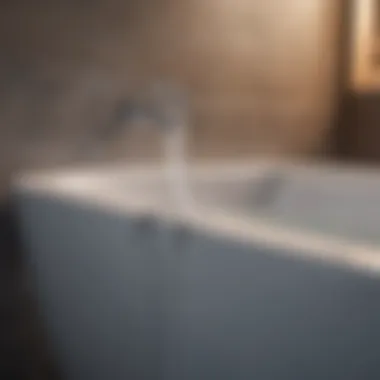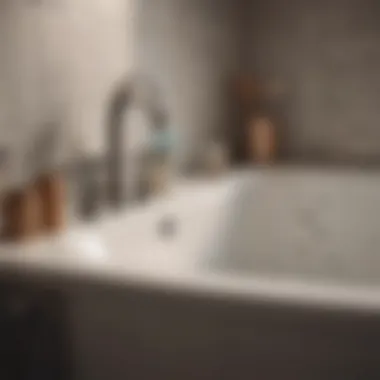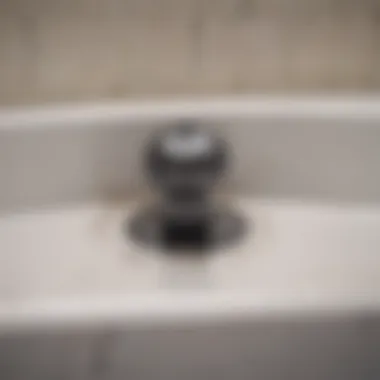Expert Techniques for Efficient Bathtub Drainage


Intro
Draining a bathtub seems simple enough, yet many homeowners overlook several critical aspects that can affect both efficiency and effectiveness. Understanding the techniques for draining a bathtub requires a blend of practical knowledge and insights into maintenance practices. Such knowledge can save time and resources in the long run.
In this guide, we will explore perils commonly encountered during draining, delve into essential tools, and present preventive measures against clogs. Staying informed about best practices will empower real estate enthusiasts and homeowners alike in maintaining their bathroom facilities. Whether you access a luxurious villa or a cozy retreat, knowing how to manage your bathtub's drainage system enriches your overall living space.
Let's examine the details critically, ensuring that you grasp not only how to drain your bathtub but also the broader implications on your home's function and comfort.
Useful Tools for Bathtub Draining
Before embarking on your drainage process, it’s vital to gather necessary tools:
- Plunger
- Drain snake or auger
- Bucket
- Towel
- Cleaning materials (like vinegar and baking soda)
With the right tools in hand, you can tackle common issues while ensuring that your experience is as seamless as possible.
Understanding Common Clogs
Clogs arise from various buildup, including:
- Hair
- Soap residue
- Mineral deposits
- Foreign objects
Identifying the type of clog can guide you toward the appropriate solution. For hair, utilizing a drain snake proves effective. However, you should approach soap buildup with vinegar and baking soda, as this natural mixture eliminates residues without harming your plumbing.
A well-maintained drainage system extends the life of your plumbing and enhances your home's value.
Preventive Measures
Building a routine of preventive maintenance will protect your bathtub from common clog issues:
- Regularly clean the drain cover, preventing hair accumulation.
- Perform flushing with vinegar monthly to mitigate soap deposits.
- Avoid tossing foreign objects into the drain.
Routine Cleaning and Maintenance
Adopt a proactive approach:
- Inspect your bathtub drainage weekly. Look at drain covers and the surrounding area for strings, hairs, and objects.
- Engage in full clean every month. Applying a mixture of baking soda followed by vinegar offers bacteriacidal effects and dislodges debris.
Prelude to Bathtub Draining
Draining a bathtub effectively is crucial for homeowners and real estate enthusiasts alike. It ensures hygiene, prevents water damage, and maintains the functionality of the bathroom. This section sets the stage for understanding the essential components of bathtub drainage systems. Proper drainage can extend the lifespan of the entire plumbing system, reducing maintenance cost over time.
Understanding Bathtub Drainage Systems
A bathtub drainage system is a complex arrangement enabling water to flow out efficiently. It consists of several key components: the drain, trap, waste pipe, and venting system.
Each part contributes to a seamless drainage experience. The drain is positioned at the lowest point of the bathtub, allowing gravity to aid in moving the water through the …pipe. The trap plays a vital role in preventing foul odors from rising, acting as a barrier against sewer gases.
The waste pipe transports the water to the household’s plumbing system, eventually linking to the sewer line. Proper ventilation is necessary to ensure that water moves without trapping air pockets, allowing effective drainage. Understanding these components provides insight into how any issue can arise from malfunctions in individual parts. It highlights the importance of regular inspections and maintenance.
Importance of Proper Drainage
Ensuring proper bathtub drainage has consequences beyond convenience. Slow drainage can lead to stagnant water, resulting in greater risks of mold growth and bacteria. Mold and mildew can be detrimental to one’s health and may cause complications in the future.


Additionally, frequent clogs can escalate into significant plumbing challenges, possibly affecting the entire system. The financial implications of emergency plumbing services can be substantial; conversely, simple regular maintenance can prevent expensive repairs.
Common Bathtub Drain Issues
Understanding the common issues related to bathtub drainage is essential as it helps identify potential problems early. Recognizing these issues means effective intervention, which saves time and resources. Homeowners especially need to address drainage problems, as neglect can transform an uneventful issue into a significant headache. Flushing and draining water gives immediate results. Any interferences cause inconvenience to daily routines. Therefore, comprehending the nature of these issues creates a smoother experience for all.
Identifying Stagnant Water
Stagnant water in a bathtub typically refers to the water that remains in the tub rather than being efficiently drained. Observing water pooling instead of flowing away invites potential problems, encouraging mildew growth and unpleasant odors. Infestations by insects are possible if neglected for long periods. The warning signs are clear:
- Persistent puddles in the tub after use
- Slower-than-normal drainage rates
Addressing stagnant water acts as a pivotal first step to draining effectively. It can save on repairs, especially the ones that might involve plumbing consultation.
Causes of Slow Draining
A slow drain mechanism can stem from various reasons. This sluggish behavior may occur in isolation or become a symptom of a broader network issue. The following factors often contribute:
- Hair: The most frequent culprit is hair aggregation, often coagulated within the drain.
- Soap Scum: Over time, soap builds up can trap debris, blocking the drain.
- Mineral Deposits: Water hardness creates buildup within pipes, especially evident in some regions where groundwater has high mineral content.
Detection requires periodic inspections. Noting drainage speed should become routine, ensuring thorough understanding of when issues start to exist. Quick acknowledgment leads to swift actions, allowing enjoyment safely.
Clogs and Their Causes
Drain clogs are a common emergency faced by bbathtub owners. Fundamental to address clogs rests upon understanding their roots. While many factors contribute, usually a combination induces onset:
- Material Buildup: Accumulation of fats, hair, and toiletries compiles inside pipes.
- Improper Disposal: Items such as sanitary products or wipes should never be flushed away, as they do not decompose easily.
- System Limitations: In older homes, plumbing systems may not support multiple demands, leading to backups at times.
All these factors indicate areas where diligence is necessary. With well-rounded knowledge, bathtubs can be maintained better and sustained in top conditions. Navigating these challenges makes life more pleasant and stress-free.
Essential Tools for Draining
When addressing the challenge of draining a bathtub, the necessity of having the right tools cannot be overstated. An efficient bathtub drainage process largely relies on specific instruments that can tackle various issues from basic clogs to more complex blockages. Each tool plays a distinct role in ensuring effective drainage, hence understanding these elements gives homeowners the confidence to manage their bathtubs properly.
Utilizing appropriate tools offers multiple benefits, especially regarding time saving and enhanced efficiency. Without the correct instrument, efforts may yield little success, potentially aggravating an existing problem. It is crucial to note that improper use of tools can lead to further damage, making the initial task more complicated. Therefore, a thorough comprehension of both basic and advanced tools is vital to securing optimal results.
Basic Tools Required
Every household should have a few essential tools handy for typical bathtub drainage issues. These tools are generally inexpensive and easy to obtain, making them accessible for most homeowners. Starting with the basics, here is a short list of must-have items:
- Plunger: A regular plunger is important for removing simple clogs. It should create a proper seal over the drain to generate enough suction.
- Bucket: Useful for catching excess water during the draining process or cleaning up any spills afterward.
- Drain Catcher: A device that fits over the drain to catch hair and debris to prevent clogs from occurring in the first place.
- Gloves: Protects hands from grime and chemicals, particularly when dealing with visible blockages.
- Towel: An absorbent choice is useful for quick clean-ups or as added insulation while working on tougher obstructions.
These basic tools form the foundation for any effective draining project. Employing them thoughtfully during the procedure can immensely streamline the operation.
Advanced Equipment for Stubborn Clogs
While basic tools cope well with common problems, stubborn clogs require advanced equipment for effective removal. Intensive blockages may call for both ingenuity and investment into these more specialized devices. The following are noteworthy options:
- Drain Snake: A flexible auger designed to break apart, grab or pull out debris along the pipe walls; very effective in reaching deep and notorious clogs.
- Wet/Dry Vacuum: A powerful vacuum can unleash enough suction to pull substantial debris from the drain, offering added assistance to stubborn situations.
- Plumbing Auger: This variant function similar to a drain snake but is often utilized for more significant drain lines and heavy-duty blockages.
- Product-specific Chemicals: Certain products may be effective against organic materials that primarily cause clogs. Yet, they must be used with caution to avoid potential side effects.
- Camera Inspection Tools: A professional-level instrument used by many plumbers that allows fast diagnostics via a visual scan of pipes, offering clarity where issues lie.
It is essential to directly benefit from advanced tools, particularly where simple methods might not suffice. Knowing when each tool's use is paramount in managing bathtub maintenance efficiently.
Step-by-Step Drainage Techniques
Understanding drainage techniques is essential for any homeowner or enthusiast concerned with maintaining proper functionality in a bathtub. These methods not only ensure effective water removal but also help to identify and address potential issues before they escalate. Various techniques exist, each serving unique situations, and by following systematic steps, you can improve the efficacy of your drainage process and extend the lifespan of the plumbing system.


Preparing the Area
Before diving into any drainage activity, preparing the area is key. This minor yet crucial step lays the groundwork for a hassle-free process. Start by removing any items around the tub that may interfere, like bath mats, bath products, or any loose items. It is also wise to put down towels on the floor to catch any spilled water. Ensure that you have your tools within reach to save time and maintain efficiency.
Attempting Basic Stoppages
Addressing basic stoppages can often resolve minor issues effectively. Sometimes water does not drain simply because there is a small obstruction. Begin by checking the drain cover; hair and debris can easily become trapped. Removing the drain cover usually allows better access for cleaning. Use a brush or a cloth to clear away any blockages in this area. This simple action can prompt the water to flow freely again without needing extensive remedies.
Using a Plunger Effectively
The plunger is an invaluable tool in combating many minor drainage issues. Ensure that there is enough water in the tub to cover the rubber part of the plunger. Create a tight seal against the drain and plunge vigorously. This action generates pressure that may dislodge clogs further down the pipe. It's effective for common household obstructions such as soap or hair accumulations. However, always confirm if the clog has cleared by running water and observing the drainage.
Employing a Drain Snake
Should basic methods fail, using a drain snake may be necessary for more profound clogs. A drain snake, or auger, is a flexible tool designed to reach into the pipes. Feed the snake through the drain until it encounters resistance, indicating a clog. By twisting and pushing the snake, the obstruction is either broken apart or pulled out. This method can engage the clog that was otherwise inaccessible, greatly enhancing the cleaning process.
Chemical Solutions: Pros and Cons
Chemical solutions can seem like an easy answer for persistent clogs. However, it is crucial to consider both the advantages and disadvantages of this approach. A primary advantage is effectiveness; powerful drain cleaners often work quickly. Conversely, these solutions can cause harm to older pipes, leading to deterioration or leaks over time.
- Pros:
- Cons:
- Quick resolution for stubborn clogs
- Typically easy to use with clear instructions
- Risk of damage to plumbing systems
- Potential hazard through chemical exposure
Thus, if using chemical solutions, opt for those labeled as safe for your plumbing type and follow the instructions rigorously. Moreover, always prioritize non-chemical methods before settling for these chemical options.
Successful drainage is retried through a methodical sequence. Whenever conventional methods don't provide relief, ensure to opt for techniques progressively; innovation often bares displays of complete water efficiency.
Preventive Measures for Drain Maintenance
Proper maintenance of a bathtub drainage system is crucial. Preventive measures serve as the first line of defense against common draining issues. Investing time in routine care can help avoid inconveniences of clogs and slow drainage.
Regular Inspection Tips
Inspecting the bathtub drainage regularly can catch issues before they escalate. Monthly looks for visible wear or accumulating debris can be beneficial. Look for signs like discoloration around the drains or excessive water pull.
Key Steps for Inspection:
- Check the stopper: Ensure it operates smoothly without residual buildup.
- Inspect plumbing connections: Look for leaks or any joint degradation.
- Observe water flow: Notice rate at which water drains, slow drainage often indicates hidden issues.
Implementing regular checks helps in maintaining the rupture-free functioning of your bathtub. Troubles detected early can save you substantial repair costs later on. It is also good to document the condition for your own comparison over time.
Best Practices for Avoiding Clogs
Preventing clogs is simpler than managing them. Performing intervals of proper upkeep along with integrating smart practices during use is vital. Rather than reactionary attempts, create an upfront game plan to keep drains running smoothly.
Suggestions for Avoidance:
- Use a Hair Catcher: This simple device prevents hair from entering the drain. Most models simply sit atop the drain area without affecting the flush.
- Avoid Flushing Non-Decomposables: It’s critical to not use the drain for anything other than bathwater, soap, and hair controls.
- Regular Cleaning: Clean the drain visually at least once a week to keep surface debris at bay. Use non-acidic cleaners that reduce buildup without damaging pipes.
- Schedule Professional Cleanings: Appoint a plumber annually or semi-annually to perform thorough cleanings and inspections.
Closely maintaining your bathtub’s drainage aspects elongate its lifespan and lessen complicated repairs, therefore resulting in less stress.
By proactively inspecting and implementing these strategies, the integrity of your bathtub drainage can be enhanced. Addressing small problems as they arise avoids more significant repairs and troubles down the line. This mindful approach provides lasting comfort in your engaging space.


Troubleshooting Common Problems
Troubleshooting common problems is a crucial skill for any homeowner. In the context of bathtub drainage, resolving these issues effectively ensures not only the immediate function of your bathtub but also prolongs the life of the plumbing system. Recognizing and addressing these problems promptly can save you substantial time and money in repairs, along with enhancing the overall hygiene of your home.
Addressing Frequent Clogging
Frequent clogging may indicate several underlying issues. Hair and soap scum often accumulate within the drain system, leading to blockage over time. Regular maintenance is important for minimizing these accumulations. Consider the following:
- Prevention: Use drain covers to catch hair and debris before they go down the drain. This simple step significantly reduces accumulation.
- Regular Cleaning: Adopt a cleaning schedule to remove potential materials that can cause clogs. A mixture of baking soda and vinegar can break down small obstructions effectively.
- Signs of Problems: If you notice gurgling sounds or slow draining, these may be early warning signs of a more severe clog. Addressing these symptoms promptly prevents larger blockages later.
“Addressing frequent clogging early can save time and future hassle.”
If basic preventative measures do not help, using tools such as a drain snake may be necessary. This device allows you to remove stubborn clogs that can create backup and unpleasant smells.
Identifying Sewer Line Issues
Sewer line issues can dramatically affect bathtub drainage. Recognizing signs of difficulties in the sewer system is vital for timely action. Here are key indicators:
- Consistent Backups: If multiple drains in your home produce backups, the issue might not lie with your bathtub but higher up in the plumbing system.
- Delayed Drainage: When sink drains or toilets begin backing up alongside the tub, professionals often look to sewer lines first as a potential source.
- Unusual Smells: Persistent unpleasant odors in your bathroom may indicate a sewer line problem. This issue requires investigation, since it may pose health risks and necessitate professional intervention.
If identified, it is advisable to turn to a professional for assistance. Avoiding DIY solutions is prudent for such issues. There can be risks of further damage that will only worsen the situation.
In summary, effective troubleshooting can minimize plumbing problems related to bathtub drainage. It involves both preventative measures for frequent clogging and careful analysis of signs indicating potential sewer line troubles.
When to Consult a Professional
Determining when to seek professional help for bathtub drainage issues can be challenging yet crucial. Many homeowners attempt to resolve problems independently, but sometimes, a situation may exceed basic do-it-yourself solutions. Identifying the right moment to contact a plumber can optimize your efforts and ward off further damage. Here are significant focus areas advocating expert intervention:
Signs You Need Expert Help
Some clues signal that expert plumbing help is necessary. Issues that linger or escalate do require careful attention:
- Persistent Clogging: If your bathtub continues to clog frequently despite using plungers, sink snakes, or chemical treatments, this can signify a deeper, underlying problem in your plumbing system.
- Slow Draining: When the bathtub drains exceedingly slow, the blockage might be due to grease, hair, or foreign materials deeper in the pipes. If you’ve tried home remedies to no avail, a plumber is advisable.
- Bad Odors: Foul smells coming from the drain can indicate sewage backup or organic matter decay, issues that require immediate professional oversight.
"Ignoring signs of plumbing issues can lead to larger complications in the drainage system."
- Unusual Noise: Gurgling sounds or bubbling when draining water can indicate air trapped in the pipes, suggesting potential blockages leading to serious plumbing issues.
- Leaks: Water leaking around bathtub fittings is not only inconvenient but could lead to further water damage and structural issues. Seeking professional help prevents amplifying these problems.
Choosing the Right Plumber
Selection of the correct plumber forms a critical component of solving drainage problems proficiently. When searching for prospective plumbing services, bear in mind the following:
- Check Licensing and Certification: Confirm the plumber holds the appropriate licenses required by local law. This ensures they are adequately trained and qualified.
- Read Reviews: Checking evaluations and recommendations from prior clients assists in gauging their reliability and level of service.
- Request Estimates: Collect several quotes to identify fairness in pricing. Avoid the lowest option that appears too good to be true—it can mask subpar service.
- Experience Matters: Consider plumbers with sustained experience in dealing with bathtub maintenance and drainage problems. Experience usually translates to better problem-solving efficiency and expertise in handling diverse situations.
- Customer Service: A supportive, attentive customer-experience should be a priority. Responsiveness and clarity in communication can significantly enhance your service experience.
Moreover, a reputable plumber may provide necessary follow-up support and advice, ensuring not just repairs but enhanced understanding of best practices in maintaining your bathtub drainage efficiently.
End
The conclusion draws together the core elements discussed throughout this article, highlighting the essential aspects of effective bathtub drainage. A thorough understanding of drainage techniques is vital for both homeowners and real estate enthusiasts. Proper drainage prevents water buildup, saving one from potential nuisances, ineffective performance, and costly repairs.
Recap of Key Points
- Understanding your bathtub drainage system is fundamental to identifying and addressing problems before they escalate.
- Stagnant water can indicate underlying issues that require immediate attention.
- Regular inspections and preventive maintenance practices keep your bathtub draining efficiently.
- Knowing when to consult a professional ensures you do not overlook serious plumbing concerns.
In essence, proficiency in basic troubleshooting techniques enhances the longevity of your plumbing.
Final Thoughts on Bathtub Care
Bathtub care encompasses much more than periodic cleaning. It involves routine inspections, awareness of usage patterns, and attentiveness to potential issues. Engage with your bathroom space actively. Monitor drainage performance regularly to prevent problems and maintain an enjoyable bathing experience.
By investing time into understanding and maintaining your bathing area, you protect your home’s value and ensure a pleasurable bathing environment for yourself and others.



